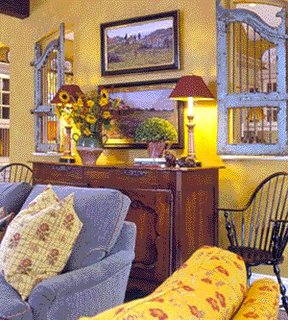
Need Help Re-Designing a Room?
Visit Our “Design Online” pages for
affordable help.
www.cottageflourishings.com
• "There just isn't any other way to arrange my furniture."
• "If I rearrange things, they just won't look right."
• "I've tried moving the living room furniture around every possible way
I could think of, and it just never looks any better. It isn't ever comfortable, either."
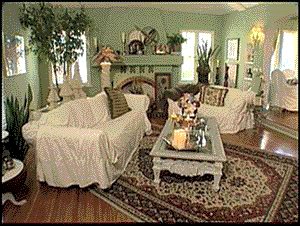
Chances are you've said these same things to yourself. There's one basic reason why you might feel unhappy with the arrangement you have, so I suggest that you take another good look at your living room right now with the following question in mind: Is all the furniture pressed against the walls?
Who can't recall a living room with all the big furnishings pressed against the walls? Lined up, one after the other, were end tables, sofas, armchairs, rockers, a piano, floor lamps. And let's not forget the wall units, armoires, bookcases, and various cabinets that may have stood side by side with them.
Do you remember how you felt in that room? Did it give you the same feeling you have in a doctor's waiting room? Was it easy to have a conversation in that room? How accessible was the coffee table? And even if the room was large, despite the space in the middle of the room, did you feel that the furniture was crowding you in, making you feel claustrophobic? The inclination to turn furniture into "wallflowers" is, unfortunately, a tradition that has been passed down from generation to generation. Perhaps it made enormous sense when there was a fire in the middle of the living space.
Today, however, there is absolutely no good reason to do so.
Pushing furniture - especially seating - up against the walls is one of the common design mistakes that I encounter. Most people assume that this configuration will create the illusion of more space or allow them to put more furniture in their room. Others believe that it permits easier access into and out of the room.
Ultimately, the only result is a "wallflower" room that feels uncomfortable and looks awkward.
And, unless the room is very tiny, it also lacks a comfortable conversation area and probably creates the roller-coaster effect with furniture of varying heights lined up against the wall.
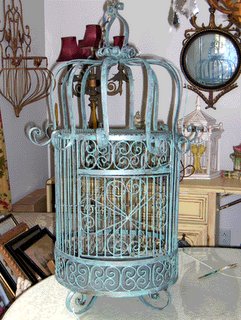 Your Furniture Placement Checklist
Your Furniture Placement ChecklistTo make sure that you have eliminated the "line-up" in your room and enhanced both its function and comfort, consider the following:
• Is the sofa or loveseat against the longest wall? Or, if at a right angle to the wall, does it define
the living space or anchor a conversation area without creating obstacles to traffic flow?
• If you own both a sofa and loveseat, is the sofa placed against the longest wall with the loveseat
at a right angle to it? Have you added one or two chairs on the opposite side to complete the grouping?
• If you own a sectional or modular unit, have you configured it to facilitate the flow of traffic
through the room?
• Are your occasional chairs positioned "off the walls" and facing each other or part of a U-shaped
arrangement with a sofa or loveseat?
• Have you removed any excess pieces, such as unneeded end tables?
Creating Fluid Traffic Patterns
In every room of your house you should be trying to create traffic patterns that let you you enter and walk around the room with the most ease. Proper furniture placement may at first seem a complicated task, b
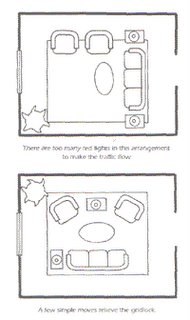 ut all it really takes is common sense and learning to look at your rooms in a new way.
ut all it really takes is common sense and learning to look at your rooms in a new way.Consider, for instance, your kitchen or dining table. Are the table and chairs accessible from three or, preferably, from four sides? They probably are. What is true for your dining room or kitchen, should also be true for your living room seating area. Every room should invite you in, not stop you at the doorway before you enter it. It's important to create a path that flows in and out of the room easily. To make sure that you have the best traffic pattern possible for your space, take note of these points:
The location of your doorways: If there are two doors, consider having the traffic pattern move behind the seating, not through it, from one door to another. If there is only a single doorway, it's best to have easy access directly to the seating, as long as you leave enough room around the sides and behind it to move comfortably.
The placement of your major piece of furniture: If your sofa is placed off the wall, leave a minimum of 2.5 to 3 feet of walking space behind it. A bit less space is needed in between chairs and the sofa.
The seating arrangement: If you have a long wall, establish your seating arrangement there, with the sofa against the wall as the anchor. Traffic will flow around it.
Obstructions: If a sofa or chair is obstructing a doorway, it must be moved.
Lethal weapons: Sharp edges on coffee tables or end tables force you to slow down or even swerve to avoid hitting them. Using round, oval, or rectangular pieces with rounded corners will contribute to a safer, more comfortable flow.

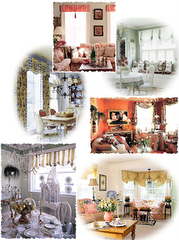

No comments:
Post a Comment